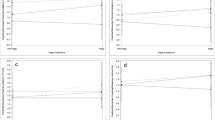Abstract
Intensity of angry feelings and styles of expressing anger were examined for their relationship to measures of the chronic pain experience. Subjects were 142 chronic pain patients. Multiple regression analyses revealed that a style of inhibiting the expression of angry feelings was the strongest predictor of reports of pain intensity and pain behavior among a group of variables including demographics, pain history, depression, anger intensity, and other styles of anger expression. In a similar manner anger intensity contributed significantly to predictions of perceived pain interference and activity level. More conservative hierarchical regression analyses supported these findings. Results are consistent with explanatory models of pain and disability that hypothesize an etiologic role of a pervasive inability to express intense negative emotions, particularly anger.
Similar content being viewed by others
References
Beutler, L. E., Engle, D., Oro'-Beutler, E., Daldrup, R., and Meredith, K. (1986). Inability to express intense affect: A common link between depression and pain.J. Consult. Clin. Psychol. 54: 752–759.
Beutler, L. E., Daldrup, R., Engle, D., Guest, P., Corbishley, A., and Meredith, K. E. (1988). Family dynamics and emotional expression among patients with chronic pain and depression.Pain 32: 65–72.
Biaggio, M. K. (1980). Assessment of anger arousal.J. Pers. Assess. 44: 289–298.
Blumer, D., and Heilbronn, M. (1982). Chronic pain as a variant of depressive disease: The pain-prone disorder.J. Nerv. Ment. Dis. 170: 381–414.
Chesney, M. A., and Rosenman, R. H. (1985).Anger and Hostility in Cardiovascular and Behavioral Disorders, Hemisphere, New York.
Cox, T., and MacKay, C. (1982). Psychosocial factors and psychophysiological mechanisms in the etiology and development of cancer.Soc. Sci. Med. 16: 381–396.
Crowne, D. P., and Marlowe D. (1960). A new scale of social desirability independent of psychopathology.J. Consult. Psychol. 24: 349–354.
DeShields, T. L., Jenkins, J. O., and Tait, R. C. (1989). The experience of anger in chronic illness: A preliminary investigation.Int. J. Psychiat. Med. 19: 299–309.
Diamond, E. L. (1982). The role of anger and hostility in essential hypertension and coronary heart disease.Psychol. Bull. 92: 410–433.
Endicott, J., and Spitzer, R. (1978). A diagnostic interview: The Schedule For Affective Disorders and Schizophrenia.Arch. Gen. Psychiat. 35: 837–844.
Engel, G. L. (1959). “Psychogenic” pain and the pain-prone patient.Am. J. Med. 26: 899.
Greer, S., and Morris, T. (1975). Psychological attributes of women who develop breast cancer: A controlled study.J. Psychosom. Res. 2: 147–153.
Haythornthwaite, J. A., Sieber, W. J., and Kerns, R. D. (1991). Depression and the chronic pain experience.Pain 46: 177–184.
Kerns, R. D., Turk, D. C., and Rudy, T. E. (1985). The West Haven-Yale Multidimensional Pain Inventory (WHYMPI).Pain 23: 345–356.
Kerns, R. D., Haythornthwaite, J., Rosenberg, R., Southwick, S., Giller, E. L., and Jacob, M. C. (1991). The Pain Behavior Checklist (PBCL): Factor structure and psychometric properties.J. Behav. Med. 14: 155–167.
King, L. A., and Emmons, R. A. (1990). Conflict over emotional expression: Psychological and physical correlates.J. Pers. Soc. Psychol. 58: 864–877.
Leiker, M., and Hailey, B. J. (1988). A link between hostility and disease: Poor health habits.Behav. Med. 14: 129–133.
Lubin, B. (1965). Adjective check lists for measurement of depression.Arch. Gen. Psychiat. 12: 57–62.
Melzack, R. (1975). The McGill Pain Questionnaire: Major properties and scoring methods.Pain 1: 277–299.
Merskey, H., and Spear, F. G. (1967).Pain: Psychological and Psychiatric Aspects, Bailliere, Tindall and Cassell, London.
Musante, L., MacDougall, J. M., Dembroski, T. M., and Costa, P. T., Jr. (1989). Potential for hostility and dimensions of anger.Health Psychol. 8: 343–354.
Pilowsky, I., and Spence, N. D. (1976). Pain, anger and illness behavior.J. Psychosom. Res. 20: 411–416.
Romano, J. M., and Turner, J. A. (1985). Chronic pain and depression: Does the evidence support a relationship?Psychol. Bull. 97: 18–34.
Schwartz, G. E., Weinberger, D. A., and Singer, J. A. (1981). Cardiovascular differentiation of happiness, sadness, anger and fear following imagery and exercise.Psychosom. Med. 43: 343–364.
Smith, T. W., and Christensen, A. J. (1992). Hostility health, and social contexts. In Friedman, H. S. (ed.),Hostility Coping and Health, American Psychological Association, Washington, DC, pp. 22–48.
Spielberger, C. D., Jacobs, G., Russell, S., and Crane, R. S. (1983). Assessment of anger: The State-Trait Anger Scale. In Butcher, J. N., and Spielberger, C. D. (eds.),Advances in Personality Assessment, Lawrence Erlbaum Associates, Hillsdale, NJ., pp. 161–189.
Spielberger, C. D., Johnson, E. H., Russell, S. F., Crane, R. J., Jacobs, G. A., and Worden, T. J. (1985). The experience and expression of anger: Construction and validation of an anger expression scale. In Chesney, M. A., and Rosenman, R. H. (eds.),Anger and Hostility in Cardiovascular and Behavioral Disorders, Hemisphere, Washington, DC, pp. 5–30.
Spielberger, C. D., Krasner, S. S., and Solomon, E. P. (1988). The experience, expression and control of anger. In Janisse, M. P. (ed.),Health Psychology: Individual Differences and Stress, Springer Verlag, New York, pp. 89–108.
Williams, R. B., Jr., Barefoot, J. C., and Shekelle, R. B. (1985). The health consequences of hostility. In Chesney, M. A., and Rosenman, R. H. (eds.),Anger and Hostility in Cardiovascular and Behavioral Disorders, Hemisphere, New York, pp. 173–186.
Author information
Authors and Affiliations
Additional information
This research was partially supported by a Department of Veterans Affairs Merit Review grant awarded to Robert D. Kerns.
Rights and permissions
About this article
Cite this article
Kerns, R.D., Rosenberg, R. & Jacob, M.C. Anger expression and chronic pain. J Behav Med 17, 57–67 (1994). https://doi.org/10.1007/BF01856882
Accepted:
Issue Date:
DOI: https://doi.org/10.1007/BF01856882




